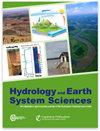技术说明:用稳定状态地表核磁共振对区域地下水位进行高密度测绘-三个丹麦案例研究
IF 5.8
1区 地球科学
Q1 GEOSCIENCES, MULTIDISCIPLINARY
引用次数: 0
摘要
摘要地下水是全球供水的重要组成部分,预计未来对这种水源的需求将会增加。为了满足对资源的需求并确保资源的可持续利用,有必要对地下水系统有越来越详细的了解。然而,由于现有的地球物理方法对岩性和孔隙流体都很敏感,因此很难直接绘制地下水地图。表面核磁共振(SNMR)是唯一一种对水具有直接敏感性的方法,它能够非侵入性地量化地下的含水量和孔隙度。尽管有这些吸引人的特点,SNMR并没有被广泛应用于水文研究,主要原因是信噪比往往较差,导致采集时间长,结果不确定性高。基于一种新型稳态方法的SNMR采集协议的最新进展证明了比以前更快地获取高质量数据的能力。这反过来又使高密度地下水测绘成为可能。我们在丹麦的三个实地活动中证明了新的稳态方案的适用性,其中进行了100多次SNMR探测,调查深度约为30米。我们展示了SNMR探测如何使我们能够在区域尺度上跟踪水位变化,并且我们展示了SNMR数据获得的水位与钻孔测量的水位之间的高度相关性。我们还将SNMR结果与独立的瞬变电磁(TEM)数据结合起来解释,这使我们能够识别小孔隙中有水的区域。在活动期间,我们优化了现场实践和SNMR采集协议,现在我们每天在8到10个地点常规测量高质量的数据。总之,三个调查的结果表明,使用稳态SNMR,现在可以用高质量的数据和较短的采集时间绘制水位的区域变化。本文章由计算机程序翻译,如有差异,请以英文原文为准。
Technical note: High-density mapping of regional groundwater tables with steady-state surface nuclear magnetic resonance – three Danish case studies
Abstract. Groundwater is an essential part of the water supply worldwide, and the demands on this water source can be expected to increase in the future. To satisfy the need for resources and to ensure sustainable use of resources, increasingly detailed knowledge of groundwater systems is necessary. However, it is difficult to directly map groundwater with well-established geophysical methods as these are sensitive to both lithology and pore fluid. Surface nuclear magnetic resonance (SNMR) is the only method with a direct sensitivity to water, and it is capable of non-invasively quantifying water content and porosity in the subsurface. Despite these attractive features, SNMR has not been widely adopted in hydrological research, the main reason being an often-poor signal-to-noise ratio, which leads to long acquisition times and high uncertainty in terms of results. Recent advances in SNMR acquisition protocols based on a novel steady-state approach have demonstrated the capability of acquiring high-quality data much faster than previously possible. In turn, this has enabled high-density groundwater mapping with SNMR. We demonstrate the applicability of the new steady-state scheme in three field campaigns in Denmark, where more than 100 SNMR soundings were conducted with a depth of investigation of approximately 30 m. We show how the SNMR soundings enable us to track water level variations at the regional scale, and we demonstrate a high correlation between water levels obtained from SNMR data and water levels measured in boreholes. We also interpret the SNMR results jointly with independent transient electromagnetic (TEM) data, which allows us to identify regions with water bound in small pores. Field practice and SNMR acquisition protocols were optimized during the campaigns, and we now routinely measure high-quality data at 8 to 10 sites per day with a two-person field crew. Together, the results from the three surveys demonstrate that, with steady-state SNMR, it is now possible to map regional variations in water levels with high-quality data and short acquisition times.
求助全文
通过发布文献求助,成功后即可免费获取论文全文。
去求助
来源期刊

Hydrology and Earth System Sciences
地学-地球科学综合
CiteScore
10.10
自引率
7.90%
发文量
273
审稿时长
15 months
期刊介绍:
Hydrology and Earth System Sciences (HESS) is a not-for-profit international two-stage open-access journal for the publication of original research in hydrology. HESS encourages and supports fundamental and applied research that advances the understanding of hydrological systems, their role in providing water for ecosystems and society, and the role of the water cycle in the functioning of the Earth system. A multi-disciplinary approach is encouraged that broadens the hydrological perspective and the advancement of hydrological science through integration with other cognate sciences and cross-fertilization across disciplinary boundaries.
 求助内容:
求助内容: 应助结果提醒方式:
应助结果提醒方式:


